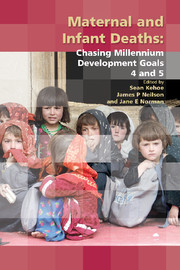Book contents
- Frontmatter
- Contents
- Participants
- Declaration of personal interests
- Preface
- The Millennium Development Goals
- SECTION 1 THE SIZE OF THE PROBLEM
- SECTION 2 CLINICAL PROBLEMS AND SOLUTIONS – MATERNAL
- SECTION 3 CLINICAL PROBLEMS AND SOLUTIONS – NEONATAL
- SECTION 4 TRAINING AND DEVELOPMENT
- SECTION 5 SPECIFIC CHALLENGES IN SPECIFIC COUNTRIES
- 17 Challenges faced in Afghanistan
- 18 Challenges faced in Zimbabwe
- 19 How Egypt has overcome the challenges
- 20 Learning from the achievements in Sri Lanka
- SECTION 6 CONSENSUS VIEWS
- Index
18 - Challenges faced in Zimbabwe
from SECTION 5 - SPECIFIC CHALLENGES IN SPECIFIC COUNTRIES
Published online by Cambridge University Press: 05 February 2014
- Frontmatter
- Contents
- Participants
- Declaration of personal interests
- Preface
- The Millennium Development Goals
- SECTION 1 THE SIZE OF THE PROBLEM
- SECTION 2 CLINICAL PROBLEMS AND SOLUTIONS – MATERNAL
- SECTION 3 CLINICAL PROBLEMS AND SOLUTIONS – NEONATAL
- SECTION 4 TRAINING AND DEVELOPMENT
- SECTION 5 SPECIFIC CHALLENGES IN SPECIFIC COUNTRIES
- 17 Challenges faced in Afghanistan
- 18 Challenges faced in Zimbabwe
- 19 How Egypt has overcome the challenges
- 20 Learning from the achievements in Sri Lanka
- SECTION 6 CONSENSUS VIEWS
- Index
Summary
Introduction
Zimbabwe faces enormous challenges in meeting the Millennium Development Goals (MDGs) 4 and 5. Some of the problems the country faces are similar to those affecting other sub-Saharan African countries but others are unique to Zimbabwe. There was a relatively stable environment for about 15 years after the country gained its independence from Britain in 1980. However, the past 10 years have been characterised by political instability and a rapidly deteriorating socio-economic environment. This has severely affected the health of women and children, who are the first to suffer under such circumstances. In this chapter, the challenges Zimbabwe has faced in the past three decades, and attempts to overcome them, will be described.
Profile of MDG indicators in Zimbabwe
The indicators for the MDGs show very slow progress or worsening since 1990 (Table 18.1). There has been a decrease in the gross national income (GNI) per capita from US$810 in 1990 to US$360 in 2005. The goal to eradicate extreme poverty and hunger is not on track and there is an increasing prevalence of malnutrition in children under 5 years. There has either been no change or there has been a worsening in the following indicators since 1990: primary school completion rate, births attended to by skilled attendants, condom use among females aged 15—24 years, incidence of tuberculosis, and life expectancy.
Maternal mortality
The maternal mortality ratio (MMR) for Zimbabwe in 1990 is not known.
- Type
- Chapter
- Information
- Maternal and Infant DeathsChasing Millennium Development Goals 4 and 5, pp. 273 - 286Publisher: Cambridge University PressPrint publication year: 2010



